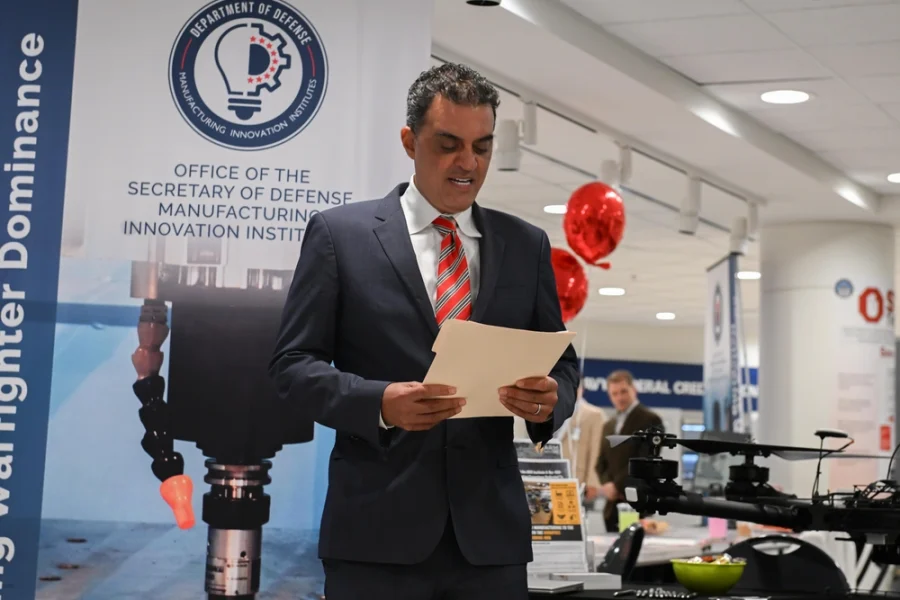The Pentagon’s head of research and engineering has tightened the number of “critical technology areas” the military services will focus on to achieve future dominance from 14 to six, and financing these areas may also be undergoing a change.
Emil Michael, undersecretary of research and engineering, said in a press release that the six CTAs “are not just priorities; they are imperatives. The American warfighter will wield the most advanced technology to maximize lethality. This is how the War Department wins wars,” he added, using the alternate name for the Defense Department authorized by executive order.
Michael trimmed the list from 14 priorities set by former head Research and Engineering Heidi Shyu in 2022, who expanded it from 11 under Michael Griffin, head of the R&E shop during President Trump’s first term. Michael telegraphed that he was planning to tighten the list in August at the NDIA Emerging Technologies Conference, when he said that the broadness of the list “diluted” the attention each top area should get. He said the new list would be more of a “pyramid hierarchy,” with the other elements still important and playing a role, but not considered of bold-faced preeminence.
In a video released on social media, Michael said that while each of the areas on the previous list “holds value, such a broad list dilutes focus and fails to highlight the most urgent needs of the war fighter; 14 priorities, in truth, means no priorities at all.”
He called the narrowing of priorities a “decisive shift,” and said the highlighted six areas will “deliver the greatest impact, the fastest results and the most decisive advantage on the battlefield.”
The new top six are:
- Applied Artificial Intelligence. Michael said this area, also called AAI, will transform “decision-making and overall operational efficiency.”
- Biomanufacturing “will harness living systems to enhance resilience and eliminate any potential supply chain vulnerabilities,” Michael said.
- Contested Logistics Technologies “will ensure our forces can operate and resupply seamlessly even in the most challenging and contested environments,” he said.
- Quantum and Battlefield Information Dominance: “Battlefield information dominance will enable war fighters to maneuver with precision, even in degraded or denied environments.”
- Scaled Directed Energy “will deliver cost-effective, high-energy solutions to neutralize any threats with unparalleled precision.”
- Scaled Hypersonics “will bring Mach Five and beyond capabilities to the battlefield en masse, striking targets with unmatched speed, survivability and lethality,” Michael said.
Dominance in these areas “will empower the warfighter to overcome adversarial threats and maintain operational dominance in any theater,” Michael said in a statement.
The “contested logistics technologies” category wasn’t on Shyu’s previous list. The others demoted from top-level focus include: Future-G Wireless; Advanced Materials; Integrated Networks and System-of-Systems; Microelectronics; Space Technology; Renewable Energy and Storage; Advanced Computing and Software; Human-Machine Interface; and Integrated Sensing and Cyber.
A former Pentagon technology official told Air & Space Forces Magazine the narrower slate “a good list,” and agreed with Michael’s comment that a too-broad table of priorities means that nothing is a priority. The person said that some of the items on the previous list—like 5G—were technology hobby horses for Pentagon leaders and didn’t really belong on it, while most of the others were “enablers” in service of the specifics that Michael put at the top and so broad that they didn’t really require the constant attention of the head of DDR&E.
Another former official said the new list could be construed as “grouping some of the previous priorities under a single title,” such as the new AI category encompassing microelectronics, software, and integrated networks.
“These priorities will ensure that our warfighters never face a fair fight,” Michael said in his recorded message. The areas are “actionable, tangible solutions to the challenges that our warfighters face today. They are driven by focus sprints designed to deliver results in the now, not in 15 years. They represent the War Department’s unwavering commitment to innovation and operational dominance.” They will be pursued “with urgency,” Michael said.
Under Griffin, most of the “principal directors” who oversaw the technology priorities “were in charge of roadmaps, but not money,” the former official said, adding that this was a “nonviable” situation. Some of those actually in charge of budgets “refused to execute” to some of those principal director roadmaps, the person said.
“There’s an effort now to give each principal director some budget authority,” the former official said, but Michael has not made any announcement to that effect.
“Our adversaries are moving fast, but we will move faster,” Michael said. Combat operators are “not asking for results tomorrow, they need them today.”


